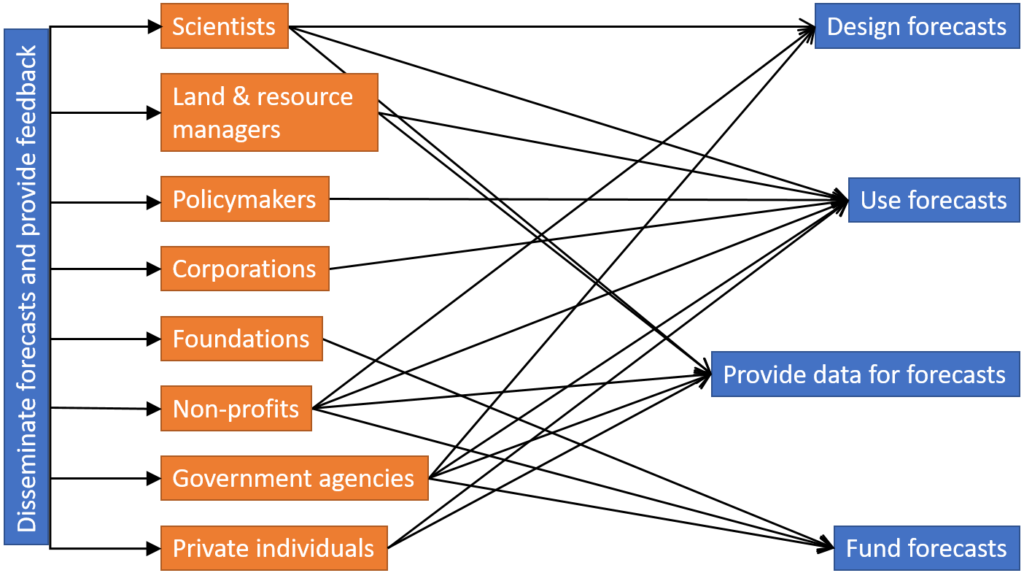Date: December 13, 2019
Post by: Kira Sullivan-Wiley1 and Jaime Ashander2
Series contributors: Mike Gerst3, Kathy Gerst4,5, Kailin Kroetz6, Yusuke Kuwayama2, and Melissa Kenney7
1Boston University, 2Resources for the Future, 3University of Maryland, 4USA National Phenology Network, 5University of Arizona, 6Arizona State University, 7University of Minnesota
Ecological forecasting involves models and ecology but is also a fundamentally people-centered endeavor. In their 2018 paper, Mike Dietze and colleagues outlined the ecological forecasting cycle (Figure 1 is a simplified version of that cycle) where forecasts are designed, implemented, disseminated, iteratively reassessed and improved through design. This cycle is about a process, and in each part of this process there are people. Wherever there are people, there are social scientists asking questions about them, their actions, and how to improve decisions made by these insights.
So we ask the questions: How might ideas from the social sciences improve ecological forecasting? What new opportunities and questions does the emerging interdisciplinary field of ecological forecasting raise for the social sciences?
This post introduces a series of posts that address these questions, discussing opportunities for the social sciences in Ecological Forecasting Initiative (EFI) and gains from considering humans in forecasting research. Thus, our aim is to better describe the role of social scientists in the ecological forecasting cycle and the opportunities for them to contribute to EFI.

So where are the people?
At EFI, we’re interested in reducing uncertainty of forecasts, but also improving the processes by which we make forecasts that are useful, useable, and used. This means improving forecasts, their design, use, and impact, but it also results in a range of opportunities to advance basic social science.
To do this we need to know: Where are the people in this process? Where among the boxes and arrows of Figure 1 are people involved, where do their beliefs, perceptions, decisions, and behavior make a difference? Are there people outside this figure who matter to the processes within it? Figure 2 highlights critical groups of people involved, and some of the actions they take, that are integral to the ecological forecasting process.

Figure 2 moves beyond the three-phase process described in Figure 1 because the process of ecological forecasting is predicated on funding sources and data, often provided by people and processes outside the forecasting process. So when we think about where social science belongs in ecological forecasting, we have to look beyond the forecasting process alone.
Making forecasts better
If EFI wants to make this process work and produce better forecasts, which of these actors matters and how? How might different stakeholders even define a “better” forecast? One might think of “better” as synonymous with a lower degree of uncertainty, while another might measure quality by a forecast’s impact on societal welfare. Ease of use, ease of access, and spatial or temporal coverage are other metrics by which to measure quality, and the relative importance of each is likely to vary among stakeholders. Social science can help us to answer questions like: Which attributes of a forecast matter most to which stakeholders, under what conditions, and why?
While a natural scientist might assess the quality of a forecast based on its level of uncertainty, a social scientist might assess the value of a forecast by asking:
- What individuals are likely to use the forecast?
- How might the actions of these individuals change based on the forecast?
- How will this change in actions affect the well-being of these or other individuals?
Building “better forecasts” will require a better understanding of the variety of ways that stakeholders engage with forecasts. The posts in this blog series will shine a spotlight on some of these stakeholder groups and the social sciences that can provide insights for making forecasts better. Posts in the series will discuss issues ranging from how stakeholders interact with forecast visualizations to the use of expert judgements in models to when forecasts should jointly model human behavior and ecological conditions. Considering these questions will help forecasters design forecasts that are more likely to increase our understanding of these socio-environmental systems and enhance societal well-being.
These examples hint at the range of potential interactions between the social sciences and ecological forecasting. There is a wealth of opportunity for social scientists to use the nascent field of ecological forecasting to ask new and interesting questions in their fields. In turn, theories developed in the social sciences have much to contribute to emerging interdisciplinary practice of ecological forecasting in socio-environmental systems. As we can see, better ecological forecasting may require us to think beyond ecological systems.
